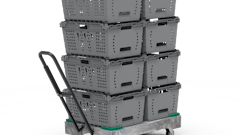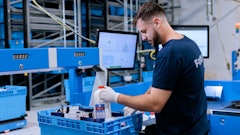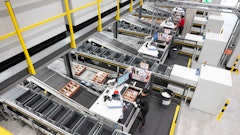If perfect order fulfillment is the universal prerequisite for any company that wants to compete as part of the CPG supply chain in 2010 and beyond, then global data synchronization is the ticket in. A lack of accurate and synchronized data was pegged early on as a chief cause behind so much of the inefficiency in the CPG supply chain.
The joint industry report released last summer, "Synchronization—The Next Generation of Business Partnering," details how companies that have already made the leap into the world of synchronized data have reaped huge benefits right away, and identified many more opportunities for further operational improvements and savings to come.
Co-sponsored by the Food Marketing Institute, Grocery Manufacturers Association, Wegmans Food Markets and 1SYNC, and conducted by Accenture, the study details a range of impressive results achieved by Wegmans and several vendor trading partners, after the retailer reached "critical mass" in terms of the number of suppliers and line items with which it had synchronized data.
The study confirmed earlier projections of significant benefits to be gained from global data synchronization. In fact, the authors of the report conclude that initial expectations were conservative.
Another surprise, says Marianne Timmons of Wegmans, was the degree to which the retailer and its manufacturer partners were able to realize significant improvements in many mission critical functions right off the bat.
"Traditionally it was thought that data sync, being foundational, wouldn't start to deliver its biggest benefits until we got everyone synchronized and speaking the same language. The idea was that you couldn't move up to higher level goals like collaborative forecasting, logistics and e-purchasing until this foundation was firmly in place."
But in fact, both retailer and manufacturers achieved some dramatic improvements in daily operations almost from the start. They were also clearly able to remove inefficiencies from the supply chain as a whole, not just shift costs. They were even quickly able to reap some early advantages in higher level activities such as faster, smoother coordination of new product introductions and promotions, and other improvements in sales and customer service.
Driving Down Transportation Costs
Transportation savings proved a big win for both sides of the equation. A key factor was the discipline imposed by the project on all the organizations involved, to verify the accuracy of every piece of product data in their item masters, and which would now be available to flow seamlessly between their various transactional systems.
"One supplier discovered through the effort that a product's weight had been incorrect for years, but had never been captured before by its internal audit systems. As a result they were overpaying freight on every case of the product that had shipped for years," points out David Garcia, vice president, strategic marketing, with 1SYNC. "By fixing this alone, the company expected to capture $2.2 million in annual savings."
Timmons says that at Wegmans, her transportation and logistics team had worked for years to improve logistics and freight costs through consolidated shipments.
"We got as creative as we could, but it always came down to the data being bad. We were limited by the inaccuracies in our system, so when a truck showed up it wouldn't have room to fit three pallets, or would be three-quarters empty," she notes.
The study indicated huge savings to be gained by both manufacturers and retailers in transportation costs. Manufacturers look to capture two to eight percent of inbound and outbound transportation cost savings, while Wegmans was on track to realize an approximate six percent cost decrease.
Participants also realized productivity gains in many facets of their operations. One manufacturer reduced a five-to-six-day, spreadsheet-based process for aligning product data with distributors to a 48-hour task. Wegmans estimated productivity savings of $1 million in its warehouse operations.
The retailer also enjoyed sizable improvements in its DSD operations, reducing time spent on items that won't scan at the back door by 25 percent, and shaving overall receiving time for DSD items by about seven percent.
In the area of new product introductions, one manufacturer saved 33 percent in administrative costs related to processing new items—the equivalent of one full-time employee. Another decreased from three days to one the time needed to gain visibility into new items though its continuous replenishment program.
A manufacturer also reported a reduction in speed-to-shelf for new items from two to four months to just two weeks, while Wegmans utilized GDS to help speed its time to shelf by seven days, a 23 percent improvement.
The retailer also saw an increase in employee productivity in entering new item information of 50 percent. It estimated an overall improvement of eight percent in accounting administration costs for all activities related to out-of-period adjustments and invoice and coupon reconciliation.
Eliminating Disruptions
In addition to the size and scope of the opportunity, another key learning from the study, Timmons says, was that while accuracy and synchronization are important and beneficial in themselves, the big goal for GDS is to eliminate or decrease all kinds of supply chain disruption, because of what that enables.
"The amount of time that can be spent on value-add activities like selling, merchandising, and building the top line, is directly related to the amount of errors, waste and inefficiencies we can take out of everyday supply chain processes," she points out.
"When a supplier and retailer sit down together on a sales call, they want to spend their time on promotional activity, not resolving data errors."
One more bit of good news in the report is that, thanks in part to efforts by pioneering companies, GDS initiatives are a lot less arduous to undertake today than just a few years ago.
Some key enablers easing the process include: improved ERP systems with built-in GDS functional and integration capabilities; process automation tools that facilitate workflow and compliance; and mature data standards.
And while Wegmans had to mount an energetic, multi-year campaign to bring enough suppliers onboard with GDS to reach the point of critical mass so it could begin to capture huge benefits, the number of companies participating and line items registered in the Global Data Synchronization Network, administered for the industry by 1SYNC, has skyrocketed in the last year.
Nearly 10,000 companies have signed up and taken at least the first step of registering a total of almost 600,000 items with global trade IDs now, Garcia points out.















